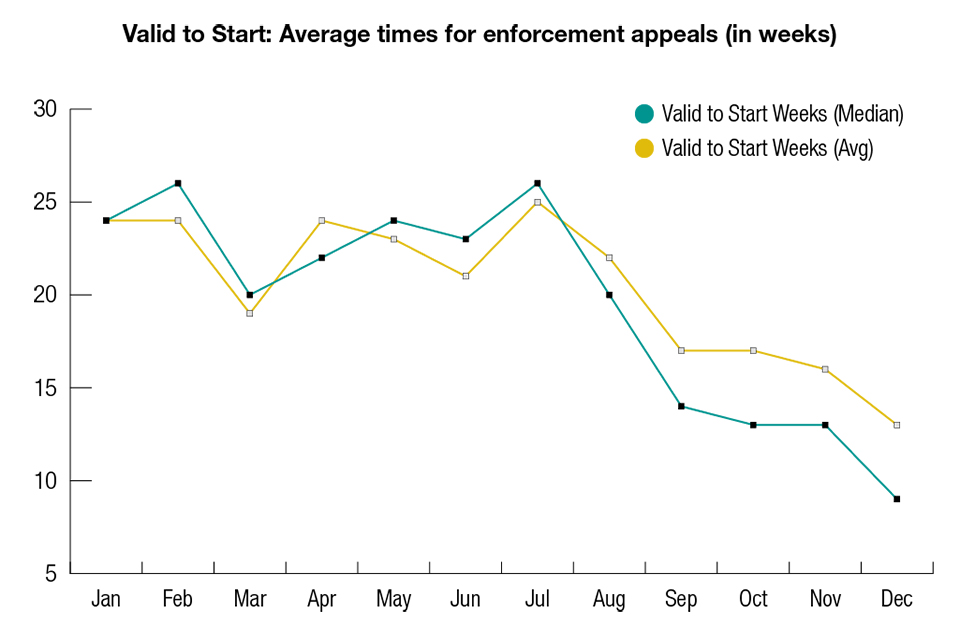
Our previous performance updates explain how the recruitment of additional inspectors, the implementation of the Rosewell Review recommendations and the new planning appeals portal are helping us improve appeal handling times and provide a much better customer service.
We are continuing to make progress and make changes which will help deliver the service our customers expect.
Planning appeals
We are continuing to improve the time taken to decide appeals. For appeals handled through written representations the average time for decision currently stands at 19 weeks; 10 weeks less than the time taken in January 2019. Historic Heritage casework was an area where appeals were consistently taking longer to determine. To improve this, we have increased the number of Inspectors who are able to deal with this type of specialist casework.
We are also making good progress with clearing older hearing cases. The number of live hearing appeals has reduced every month for the last six months. The median decision time is now 32 weeks compared to a high of 47 weeks over the summer of 2019. The valid-to-start data for hearings shows

Enforcement
Performance is improving for Enforcement appeals with the number of decisions issued increasing in the last three months. This is as a result of the additional Inspectors who have been trained to undertake this type of casework. The time for new cases to be assessed for validity is on average 2 weeks and the waiting time for written representations appeals to be started has reduced significantly. This means that written representation appeals submitted now are likely to hit the valid-to-decision target of 36 weeks.
Our focus is now on handling times for Enforcement hearings and inquiries. We are expecting to see an improvement in this area later this year.

Rosewell Review
Following the Rosewell Review, which was published on 12th February 2019, 15 of the 22 recommendations are now implemented.
We are holding a 'One year on event' in February for parties involved in the Review and its implementation, to consider what has gone well and where further focus is still required. We will also publish another update of the Action Plan at the beginning of March. This will provide details on the progress made to date and planned improvements for the remainder of this year.
All Inspector decided inquiry planning appeals submitted to the Inspectorate since 1 April 2019 have followed the Rosewell timing recommendations. All except one were decided in fewer than 26 weeks. On average the cases took 22 weeks to decide and 10 were decided in 20 weeks or fewer.
As we continue to improve our guidance, we have produced the following video for Rule 6 parties. Narrated by our senior Inspector, Jenny Vyse, the video answers questions most commonly asked and talks through the process of how to become a Rule 6 party.
Cases for Decision by Secretary of State
Following the successful implementation of many of the recommendations in the Rosewell review for Section 78 appeals and the publication of our updated Action Plan in October 2019, we have started looking into ways of implementing some of the Rosewell recommendations for the processing of called in planning applications. From now on we will work with those applicants whose applications are called in and the local planning authorities involved. This moves away from our "bespoke" process where we would have invited the parties to agree a programme, including an inquiry date.
This is the next step in significantly shortening the delays in arranging planning inquiries, and will speed up the time from when the application is called in to the issue of the Secretary of State's decision. In the meantime we will not be able to "bring forward" inquiries already arranged, and the previously agreed bespoke programmes in those cases will continue to apply. Our published Guidance will be updated as we move forward with this work.
Local Development Plans
There were 43 local plans submitted to the Planning Inspectorate in 2019 with 59 final Inspector reports issued in the year, all of which found the plans sound. 2 local plans were withdrawn in 2019. There are currently 77 local plans in progress.
National Infrastructure Planning
We currently have 30 live cases (15 energy and 15 transport). These include the longest linear Nationally Significant Infrastructure Project (NSIP) examined (Southampton to London Pipeline Project), the first solar NSIP (Cleve Hill Solar Park), the first interconnector (Aquind) and our first consideration of separate, simultaneous applications (East Anglia 1 North and East Anglia 2).
We are also expecting some 30 projects in 2020. These include substantial cases such as Sizewell C Nuclear Power Station, Lower Thames Crossing, Luton Airport and the expansion of Heathrow Airport. The Inspectorate has met all its statutory deadlines for National Infrastructure and submitted 16 recommendation reports to the relevant Secretaries of State over the course of 2019.
Making it easier to submit an appeal
Work to improve the Appeal Casework Portal is continuing. The Beta phase continues to gather important information from users to help us refine the system currently in development. We have received 132 appeals through the new Portal, 26 of which have progressed all the way through to the decisions being issued. The project team are currently working on developing the functionality to allow linking of multiple appeals for the same development appeals and building the functionality to process other appeal types such as Technical Design Consent & Permission in Principle. Alongside this a steady flow of continuous improvements are being made to the system based on the valuable feedback already received.






